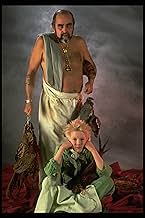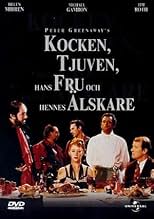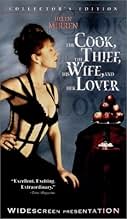Der Koch, der Dieb, seine Frau und ihr Liebhaber
Originaltitel: The Cook, the Thief, His Wife & Her Lover
Die Frau eines gewalttätigen Gangsters findet Trost in den Armen eines freundlichen Stammgastes des Restaurants ihres Mannes.Die Frau eines gewalttätigen Gangsters findet Trost in den Armen eines freundlichen Stammgastes des Restaurants ihres Mannes.Die Frau eines gewalttätigen Gangsters findet Trost in den Armen eines freundlichen Stammgastes des Restaurants ihres Mannes.
- Regie
- Drehbuch
- Hauptbesetzung
- Auszeichnungen
- 7 Gewinne & 11 Nominierungen insgesamt
Ciarán Hinds
- Cory
- (as Ciaran Hinds)
Roger Ashton-Griffiths
- Turpin
- (as Roger Ashton Griffiths)
Empfohlene Bewertungen
Imagine the universe as a restaurant. The parking lot is the world. The kitchen is purgatory. The ladies's room is heaven. The dining room is hell. Hell is ruled over by Albert Spica, (Satan) excellently played by Michael Gobon. Dante is Michael (Alan Howard) a cataloger of French books. Beatrice, Dante's perfect woman, Georgina Spica (Helen Mirren) who is married to the devil.
In the beginning, the cook (God) in the real world is seen kicked and smeared and fed dog feces by Gabon. He is humiliated and in tears, but He endures and eventually helps to further the love between Howard and MIrren. Sex, in its pure form, is looked at as something sacred. Gabon lords over everyone in his realm with a tyrant's fist, caring nothing about anyone or anything. He wants two three things out of lifesuperiority to all other being, food and sex, while Mirren, as a reluctant Persephone, sneaks off to be with Howard. A couple of times Gabon even finds his way into the sanctity of heaven, but this is only short-lived.
The mood of the film is dark-black, heralded by brilliant reds or greens, and the tenor of an angelic child throughout. Every image is like a painting. Emotions creep in from all directions.
This is a film that would never, no matter what year it was produced, have won an Academy Award. It is too refined, to subtle, too sensual, too intelligent.
Watch it, rent it, buy it. It must be seen.
In the beginning, the cook (God) in the real world is seen kicked and smeared and fed dog feces by Gabon. He is humiliated and in tears, but He endures and eventually helps to further the love between Howard and MIrren. Sex, in its pure form, is looked at as something sacred. Gabon lords over everyone in his realm with a tyrant's fist, caring nothing about anyone or anything. He wants two three things out of lifesuperiority to all other being, food and sex, while Mirren, as a reluctant Persephone, sneaks off to be with Howard. A couple of times Gabon even finds his way into the sanctity of heaven, but this is only short-lived.
The mood of the film is dark-black, heralded by brilliant reds or greens, and the tenor of an angelic child throughout. Every image is like a painting. Emotions creep in from all directions.
This is a film that would never, no matter what year it was produced, have won an Academy Award. It is too refined, to subtle, too sensual, too intelligent.
Watch it, rent it, buy it. It must be seen.
With the Cook, the Thief, his Wife and her Lover, Greenaway creates a self-contained world that is both a fabrication and abstraction of reality, but also an extremist reflection (nee, microcosm) of British society in the nineteen-eighties. The characters that he chooses to put forward to the audience as protagonists are archetypes of social and political caricatures that we would find in that particular decade; but heightened to conform to the over-the-top opulence/pestilence found central to the plot. His ability to craft characters and situations that resonate beyond the context of a particular scenario, coupled with his bitterness and unwillingness to conform is what sets him up as a satirist of serious note. He also elevates the film beyond the realms of mere art-house experimentation by fashioning a seriously funny script, which has ample opportunities for central character Albert Spica to prove himself the ultimate charismatic bully - part cockney hard man, part pantomime villain - who is never less than compulsively terrifying.
The plot is a simple construct centred on the theme of revenge and the need for personal freedom. This is mixed in with the socio-political undertones as well as Greenaway's many references to art, theatre, film and literature. It is also elevated by the impeccable cinematic qualities that we hold synonymous with the director's work. Everything here is about pushing things beyond the reasonable limitations; so we have a stunningly intricate set that is both theatrically simplistic, but also as other-worldly as anything from the work of say Gilliam or Jeunet. The costumes by Jean Paul Gaultier scream over-the-top chic, whilst often mirroring the use of colour employed by the production designers. Greenaway even breaks continuity by having Helen Mirren's costumes change colour as she moves through each room of the restaurant, so that we have a green dress in the kitchen, a red dress in the dinning area (inspired by Hitchcock's vertigo no less) and a white dress in the lavatory. It's an audacious move, but one that pays off in the creation of a completely self-contained world; something that is further established by Sacha Vierny's sumptuous cinematography and the wonderfully bombastic music of the ever-excellent Michael Nyman.
Some have clearly found the film's various abstractions problematic (yes, it is theatrical, yes it is occasionally shocking, and yes, it does evolve in a world of its own ostentatious creation). But it's also as artistic a film as you can get; a fact that some here have disputed. The reason that some define this as artistic refers to the use of colour, light and composition. The architecture of the sets too, and the way in which the production designers have chosen to dress them also adds to the artistic stylisation of the film. These factors are important to the narrative, as they are symbolic to what Greenaway is trying to convey, as well as what the characters are all about. Because of this, the design of the film becomes AS important as the framework, if not more so. But this film is more than a mere arty exploration; it's funny and intelligent and features a slew of great performances from a wonderfully eclectic cast. Michael Gambon as the thief Spica gives a grandstand performance to rival his own Phillip Marlow from The Singing Detective; hamming things up spectacularly but still retaining that much needed sense of humanity. The same can be said of the other principals too.
Mirren as the wife exudes a quite and restrained sexuality in what must be her best performance, whist Richard Bohringer as the cook is in some represents the linchpin/catalyst for the film. Elsewhere we find everyone from Tim Roth to Ian Dury popping up to give the film some added character and easily furthering the film's already cult appeal. This was a turning point for Greenaway; a move towards the more expressive, elaborate and self-contained style of film-making found in films like Prospero's Books and the Baby of Maçon and away from the more easy to digest classics like the Draughtsman's Contract, Drowning by Numbers and A Zed and Two Noughts.
The plot is a simple construct centred on the theme of revenge and the need for personal freedom. This is mixed in with the socio-political undertones as well as Greenaway's many references to art, theatre, film and literature. It is also elevated by the impeccable cinematic qualities that we hold synonymous with the director's work. Everything here is about pushing things beyond the reasonable limitations; so we have a stunningly intricate set that is both theatrically simplistic, but also as other-worldly as anything from the work of say Gilliam or Jeunet. The costumes by Jean Paul Gaultier scream over-the-top chic, whilst often mirroring the use of colour employed by the production designers. Greenaway even breaks continuity by having Helen Mirren's costumes change colour as she moves through each room of the restaurant, so that we have a green dress in the kitchen, a red dress in the dinning area (inspired by Hitchcock's vertigo no less) and a white dress in the lavatory. It's an audacious move, but one that pays off in the creation of a completely self-contained world; something that is further established by Sacha Vierny's sumptuous cinematography and the wonderfully bombastic music of the ever-excellent Michael Nyman.
Some have clearly found the film's various abstractions problematic (yes, it is theatrical, yes it is occasionally shocking, and yes, it does evolve in a world of its own ostentatious creation). But it's also as artistic a film as you can get; a fact that some here have disputed. The reason that some define this as artistic refers to the use of colour, light and composition. The architecture of the sets too, and the way in which the production designers have chosen to dress them also adds to the artistic stylisation of the film. These factors are important to the narrative, as they are symbolic to what Greenaway is trying to convey, as well as what the characters are all about. Because of this, the design of the film becomes AS important as the framework, if not more so. But this film is more than a mere arty exploration; it's funny and intelligent and features a slew of great performances from a wonderfully eclectic cast. Michael Gambon as the thief Spica gives a grandstand performance to rival his own Phillip Marlow from The Singing Detective; hamming things up spectacularly but still retaining that much needed sense of humanity. The same can be said of the other principals too.
Mirren as the wife exudes a quite and restrained sexuality in what must be her best performance, whist Richard Bohringer as the cook is in some represents the linchpin/catalyst for the film. Elsewhere we find everyone from Tim Roth to Ian Dury popping up to give the film some added character and easily furthering the film's already cult appeal. This was a turning point for Greenaway; a move towards the more expressive, elaborate and self-contained style of film-making found in films like Prospero's Books and the Baby of Maçon and away from the more easy to digest classics like the Draughtsman's Contract, Drowning by Numbers and A Zed and Two Noughts.
My introduction to Greenaway was `Prospero's Books,' which I rate very highly. I next saw `The Pillow Book,' which also was magic. I now delve into this earlier work, which is before Greenaway became master of overlayed windows. And also before he developed (at least in the two films mentioned) a clean sense of layering allegory.
In this early film the sense of allegory is simplistic, and the notion of narrative is largely abandoned. All in all, this is a cleaner film. Greenaway's fulcrum is the creation of a massive clockworks kitchen with dozens of concurrent, interrelated processes. Everything revolves around this, or more precisely the vision of this. Around this center, we see both vile and sublime forces acting on the kitchen, which is a sort of metalevel over the world from which creation emanates.
I suppose many will remember some of the more disturbing incidental images. Not me. I'll remember that extraordinary kitchen.
In this early film the sense of allegory is simplistic, and the notion of narrative is largely abandoned. All in all, this is a cleaner film. Greenaway's fulcrum is the creation of a massive clockworks kitchen with dozens of concurrent, interrelated processes. Everything revolves around this, or more precisely the vision of this. Around this center, we see both vile and sublime forces acting on the kitchen, which is a sort of metalevel over the world from which creation emanates.
I suppose many will remember some of the more disturbing incidental images. Not me. I'll remember that extraordinary kitchen.
The cruel and sadistic crime boss Albert Spica (Michael Gambon) has dinner every night in his restaurant with his wife Georgina Spica (Helen Mirren) and his gang. Albert abuses of his wife, his gangsters, the chef Richard Borst (Richard Bohringer) and the restaurant employees.
When Georgina meets the gentle bookseller Michael (Alan Howard) in the restaurant, they have a torrid affair in the restroom and in the store, and they are covered by Richard. However the prostitute Pat discloses to Albert that he has been betrayed by Georgina and Albert kills Michael. However Georgina plots revenge against Albert with the support of Richard and the victims of Albert.
"The Cook the Thief His Wife & Her Lover" is one of the most grotesque, eschatological, bizarre and weird films that I have ever seen. But it is also absolutely original and mesmerizing, with intense use of colors, and with the contrast of vulgarity and art. Food, eschatology, sex, cruelty, torture, cannibalism and revenge are entwined along 124 minutes running time. The result is not pleasant and only specific audiences will appreciate this film. Last time I had seen this film was on 08 September 2000 on VHS. My vote is eight.
Title (Brazil): "O Cozinheiro, o Ladrão, Sua Mulher e o Amante" ("The Cook the Thief, His Wife and the Lover")
When Georgina meets the gentle bookseller Michael (Alan Howard) in the restaurant, they have a torrid affair in the restroom and in the store, and they are covered by Richard. However the prostitute Pat discloses to Albert that he has been betrayed by Georgina and Albert kills Michael. However Georgina plots revenge against Albert with the support of Richard and the victims of Albert.
"The Cook the Thief His Wife & Her Lover" is one of the most grotesque, eschatological, bizarre and weird films that I have ever seen. But it is also absolutely original and mesmerizing, with intense use of colors, and with the contrast of vulgarity and art. Food, eschatology, sex, cruelty, torture, cannibalism and revenge are entwined along 124 minutes running time. The result is not pleasant and only specific audiences will appreciate this film. Last time I had seen this film was on 08 September 2000 on VHS. My vote is eight.
Title (Brazil): "O Cozinheiro, o Ladrão, Sua Mulher e o Amante" ("The Cook the Thief, His Wife and the Lover")
I sat transfixed by this film's ability to become increasingly depraved, always without any redeeming quality whatsoever. We would have left except that I became fascinated by the ability of the director and writer to hit bottom and then keep drilling. The story is familiar enough but there are no protagonists. There really are no antagonists either. Just a bunch of people you care nothing about doing things you don't want to know about. If a friend did this stuff to another human and wanted to tell you about it, you would scream for him/her to stop.
To top it off it has a score by Michael Nyman who had just enough talent to write one bad film score and retreads it for every film that a producer is stupid enough to hire him to score.
To top it off it has a score by Michael Nyman who had just enough talent to write one bad film score and retreads it for every film that a producer is stupid enough to hire him to score.
Wusstest du schon
- WissenswertesThe four title characters were named for the actors and actress writer and director Peter Greenaway originally wanted to play them. Richard (The Cook) was for Richard Bohringer, the only one of Greenaway's original choices retained in the final movie. Albert (The Thief) was named after Albert Finney, while Georgina (His Wife) was for Georgina Hale. Michael (The Lover) was named, interestingly enough, for Sir Michael Gambon, who Greenaway eventually re-cast as Albert.
- PatzerWhen Albert (Michael Gambon) goes into the ladies' toilet and starts throwing women out of the cubicles, the second one has, as you would expect, her underwear around her knees. But her skirt rides right up, revealing that she is still wearing her underwear and that the ones below are a prop.
- Crazy CreditsClosing credits epilogue: "And a special thanks to those very many people who patiently & repeatedly performed as patients & nurses in the hospital ward, and as diners in the Hollandais Restaurant."
- Alternative VersionenAn edited, R-rated version is available on video.
Top-Auswahl
Melde dich zum Bewerten an und greife auf die Watchlist für personalisierte Empfehlungen zu.
Details
- Erscheinungsdatum
- Herkunftsländer
- Offizieller Standort
- Sprachen
- Auch bekannt als
- El cocinero, el ladrón, su esposa y su amante
- Drehorte
- Produktionsfirmen
- Weitere beteiligte Unternehmen bei IMDbPro anzeigen
Box Office
- Bruttoertrag in den USA und Kanada
- 7.724.701 $
- Eröffnungswochenende in den USA und in Kanada
- 252.223 $
- 8. Apr. 1990
- Weltweiter Bruttoertrag
- 8.527.316 $
- Laufzeit
- 2 Std. 4 Min.(124 min)
- Farbe
- Seitenverhältnis
- 2.35 : 1
Zu dieser Seite beitragen
Bearbeitung vorschlagen oder fehlenden Inhalt hinzufügen






































